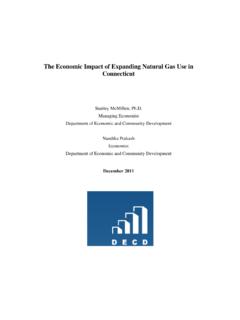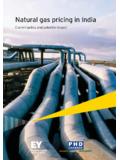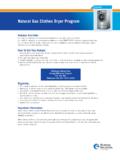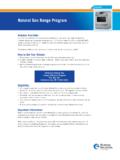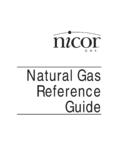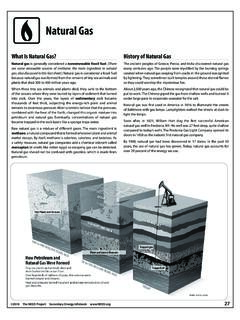Transcription of NATURAL GAS FLOWMETERS - Emerson
1 A10 June 2016 Applied AutomationTrillion cubic feetHistory2011 Projections19901995200020052010201520202 0252030203503530252015105 Shale gasTight gasCoalbed methaneAssociated with oilAlaskaNon-associated offshoreNon-associated onshoreNATURAL GAS FLOWMETERSS electing owmeters for NATURAL gasDifferent parts of the NATURAL gas delivery chain require different instruments, such as differential pressure (DP), ultrasonic, and Coriolis the last few years, there has been a tremendous increase in production of NATURAL gas, much of it derived from frack-ing plays. According to the federal Energy Information Administration (EIA), dry NATURAL gas shipments increased from 1 trillion ft3 in 2000 to 5 trillion ft3 in 2010, and production increased by a factor of 12 in one decade s time. EIA predicts that by 2035, shale gas will account for nearly half of all gas production (see Figure 1).
2 Flow measurement is critical at all points of the supply chain. Both fiscal and custody transfer measurements are needed in many of these points, but the appropriate instruments to make those measurements measurement versus custody transferCustody transfer is one of two forms of fiscal mea-surement. The other is allocation, defined as the transfer of goods between two points generally not governed by a buy/sell contract, while custody transfer is done under a contractual obligation between buyer and seller that may require adherence to accuracy, repeatability, linearity, or uncertainty standards defined by measurement standards such as American Gas Association (AGA), American Petroleum Institute (API), International Organization for Standardization (ISO), GOST (Russian equivalent to API), and so forms of fiscal measurement can be affected by product quality, fluid properties and composition, operating parameters, maintenance practices, and technology gas custody-transfer flow measurement can take place anywhere along the process value chain from the wellhead to delivery or sale location, for the lowest uncertainty in measurement, it generally takes place at stable, predictable single-phase locations or physically discrete hand-over points ( , platform/pro-duction exit location, pipeline entry/exit, terminal entry, etc.)
3 These locations generally provide the favorable conditions in which most flow measurement devices can operate with some degree of predictability and for uncertainty in fiscal measurementThe enormous value of gas involved makes accuracy essential. At current gas prices, an error of 1% in measur-ing 300 million ft3 of gas per day can lead to a difference of about $2 million per year (see Figure 2).Available technologiesHere, three technologies: differential pressure (DP), ultrasonic (both of which measure volumetric flow), and Coriolis, which directly measures mass flow are discussed. Simple volumetric flow measurement technology is not the only consideration because the ultimate measurement and what the customer pays for is energy delivered. For this reason, accurate and repeatable measurement of NATURAL gas flow requires simultaneous mea-surement of several other variables, includ-ing pressure, temperature, density, and gas Dan HackettEmerson Process ManagementFigure 1: The Federal Energy Information Agency predicts that by 2035, shale gas will account for nearly half of all gas production.
4 Courtesy: Federal Energy Information AgencyApplied Automation June 2016 A11DP metersDP meters measure volumetric flow through a calibrated orifice (generally a flow plate), are inexpensive, and simple in concept. They are accepted broadly and are not limited in line size. While not the most accurate instruments avail-able, they are acceptable for the purposes for which they are used, and the calculations for cor-recting to standard conditions are widely meters measure only differential head. To measure either mass or volumetric flow, they must be corrected for density (mass) or tempera-ture, pressure, and gas composition to obtain a standard reading. They have low turndown unless the orifice plate is changed. In addition, they are subject to fouling, which can partially obstruct the orifice plate and cause the meter to read high. The only way to counter fouling in a DP meter is to send someone out periodically to inspect the orifice plate, which is expensive in terms of labor and can mean an interruption in production.
5 In addition, DP meters are sensi-tive to flow profile and require either a fairly long straight run or an upstream flow conditioner. They also generate a medium-to-large pres-sure loss, and they are not as accurate as other technologies, such as gas turbine, ultrasonic, or Coriolis meters. The use of DP meters for cus-tody transfer is governed by API in North America and ISO 5167 metersCoriolis FLOWMETERS measure mass flow and den-sity directly. They do not need pressure and tem-perature compensation for fluid properties. They feature wide turndown ratios and do not experience performance or calibration drift. They work well where product density is not stable, such as, for example, critical-phase ethylene. Unlike DP and ultrasonic meters, they do not require flow conditioning. In addition, most Coriolis meters are available with self-diagnostics that can detect when they are beginning to foul (they exhibit a change in baseline frequency response) without having to send someone out to open and examine the meter.
6 In addition, a Coriolis meter can detect the onset of two-phase meters are physically large, relatively expensive, and produce pressure drop (see Figure 3). In addition, they generally are not available in sizes larger than 16 in. (and, in fact, are often one or two pipe sizes smaller than the lines in which they are installed, which contributes to pres-sure drop). For this reason, they are generally restricted to applications in which pressure drop is of limited s interesting to note that while a Coriolis meter will give a density reading, in many markets, much of the accounting is done in terms of standard volume, which means it is still necessary to measure temperature and pressure, as well as gas composition. The use of Coriolis meters for custody transfer is governed by metersUltrasonic FLOWMETERS measure volumetric flow rates. Advantages include standard volume flow accuracy of to , with available, as well as negligible pressure drop and high turndown capability.
7 The high turn-down makes them useable in applications subject to wide variations in flow, which means that a single ultrasonic meter can replace multiple other meters (see Figure 4).Limitations of ultrasonic meters include the need for suf-ficient straight-run upstream or a flow conditioner. Because the accuracy of an ultrasonic meter depends on the accuracy with which the flow profile inside the instrument is known, ultrasonic meters for custody transfer applica-Figure 3: The pressure drop associated with a Coriolis meter tends to restrict its use to smaller line sizes. Courtesy: Emerson Process ManagementFigure 2: This graph shows financial risk versus measurement uncertainty. Courtesy: Emerson Process ManagementFigure 3: The pressure drop associated with a Coriolis meter tends to Tu r n d o w n500:1100:120:110 (12)( )( )( )( )( )0369121518102030405060 Nominal flow rate, %Pressure drop,psi (bar)Flow accuracy error,% of rate708090100100 :120:110:15:12:11:1 Pressure Drop(psi)(bar)Accuracy (+_%)A12 June 2016 Applied Automationtions generally use a minimum of four paths.
8 A number of six-path and eight-path meters have been introduced, but research (Klaus Zanker, Letton Hall Group, and Tom Mooney, Emerson Process Management [now with BP]), Limits on Achieving Improved Performance from Gas Ultrasonic Meters and Possible Solutions, presented at the 30th International North Sea Flow Measurement Workshop, Oct. 23-26, 2012) has shown that little is gained by exceeding four are meters with more than four paths. However, the additional paths usually are provided as a separate flowmeter within the same flowmeter body as a means of checking the overall operation of the meter (see Figure 5). There is, in fact, an eight-path meter available that is essen-tially a pair of four-path meters in a redundant important feature of many ultrasonic meters is their built-in diagnostics, which enable them to detect the pres-ence of liquids (two-phase flow), dirt buildup, blockage, and other problems.
9 And because they measure speed of sound in the gas, they can help provide a sanity check on other instruments, such as gas chromatographs, and check the accuracy of mathematical conversion to stan-dard pressure elsewhere in the system. The ultrasonic meter constantly measures the speed of sound in the flowing gas. The unit s built-in flow computer functional-ity also can calculate the speed of sound based on input data from pressure and temperature transmitters and a gas chromatograph (GC). Any disagreement between the computed and measured values indicates a problem somewhere in the ultrasonic meter is very effective at detecting two-phase flow; the presence of liquids generally indicates a problem elsewhere in the system (or that the ultrasonic meter has been installed at the wrong location). The sud-den appearance of liquids can indicate a problem with the separation equipment upstream of gas processing, while any ethanes or propanes that condense out of the NATURAL gas flow downstream of gas processing are products that should have been separated for sale as liquids and indi-cate process issues with the gas processing plant.
10 The use of ultrasonic meters for custody transfer is governed by AGA-9 and ISO/DIS 17089-1 (see Figure 6).Flow computersFlow computers measure, monitor, and may provide control of gas flow for all types of meters. They usually are mandatory for custody transfer applications. The flow computer receives volumetric flow measurement data from DP or ultrasonic gas meters, along with temperature and pressure, and calculates the flow rate. To calculate the energy flow, the flow computer needs information on gas composition (percentage of methane and heavy hydrocarbons, as well as any nitrogen and carbon dioxide) and density. Because a Coriolis meter measures mass flow directly, much of the calculation can be done by a flow computer built into that flow computer also acts as a record keeper recording date and time, instanta-neous, hourly, and daily data. It stores date/time-stamped volume records in memory long enough for a host system to retrieve the records as well as to allow time for human intervention if this retrieval fails to gas is differentIt s important to note that shale gas, which is what is fueling the transformation of the energy industry, is different from conventional NATURAL gas in several important ways.











